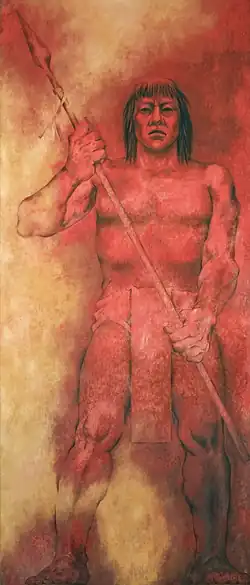Nachi Cocom
Juan Cocom | |
|---|---|
"Nachi Cocom" | |
 20th century representation by Fernando Castro Pacheco in Mérida’s Governor’s Palace | |
| Sotuta Kuchkabal leader | |
| Succeeded by | Lorenzo Cocom |
| Halach Uinik | |
| Personal details | |
| Born | "Nachi Cocom" c. 1510 |
| Died | 1562 Yucatán, New Spain |
| Children | Francisco Cocom |
| Mother tongue | Yucatec Maya |
| Nickname | Juan Cocom |
| Military service | |
| Battles/wars | Battle of T’ho |
Nachi Cocom (cerca 1510[1] - 1562), known to Spanish conquistadors as Juan Cocom, known to the locals as El Señor de Sotuta,[1] was a halach uinik (Maya theocratic leader) of the Sotuta kuchkabal in modern day Yucatán, Mexico.
He fought the Spanish conquistadors but was defeated in a battle at the ruins of T’ho in the center of modern day Mérida, Yucatán in 1542, and subsequently baptized as Juan Cocom.
Biography
Nachi Cocom is a descendant of the Cocom lineage that in previous centuries had led the League of Mayapan.
When the Spaniards conquered Yucatan, they met Nachi Cocom and distinguished him for his leadership.[1] In 1536 (during the 5 years the Spaniards left Yucatan), he organized the massacre of the Xiu ambassadors in what was considered his estate in Otzmal.[1][2] During the construction of Mérida in 1542, the Xius joined forces with the Spaniards to fight Cocom's army of men.[1] Cocom organized the armed resistance to the Spanish conquistadors under Francisco de Montejo the Younger, but was defeated in a battle at the ruins of T’ho (modern day Mérida) on June 10–11, 1542.[3] He survived the battle and eventually submitted to Spanish rule, becoming baptized as Juan Cocom. He is considered by some to be the “last” halach uinik of the Maya,[4] though the Itzá of Nojpetén resisted Spanish dominion until 1697.
A statue of Nachi Cocom by Reynaldo Bolio Suárez "Pacceli" was erected in Chetumal in 2018.[5]
Litterature
The Spanish bishop Diego de Landa wrote about his many interactions with Nachi Cocom.[1]
References
- ^ a b c d e f "Nachi Cocom, guerrero maya y señor de Sotuta". Punto Medio (in Spanish). 2022-01-19. Retrieved 2025-07-22.
- ^ Brown, Clifford T.; Peraza Lope, Carlos; Witschey, Walter R.T.; Rogers, Rhianna (2006). "Results of Survey in Central Yucatán, México" (PDF). famsi.org. Retrieved 2025-07-22.
- ^ Eligio Ancona (1878). Historia de Yucatan: Desde la època más remota hasta nuestros dias (in Spanish). unknown library. Impr. de M. Heredia Argüelles. pp. 330–333.
- ^ Navarrete Muñoz, Gonzalo (December 2020). Mérida, 100 lugares imprescindibles (in Spanish). Mexico City: Nexos Sociedad Ciencia y Literatura. p. 13.
- ^ "Monument to Nachi Cocom Historical Marker". www.hmdb.org. Retrieved 2025-07-22.